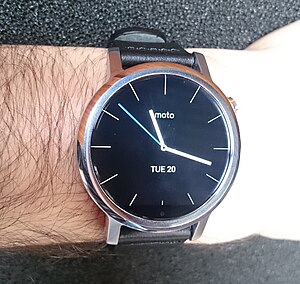Motorola Moto 360 (2015)
| Moto 360 (2015) | |
|---|---|

Moto 360 (2015), 42 mm diameter |
|
| Manufacturer | Motorola Mobility |
| publication | September 2015 |
| Technical specifications | |
| display | 1.37 ″ / 1.56 ″ diameter 360x325 / 360x330 |
| Current operating system | Android Wear 2.0 |
| processor | Snapdragon 400 (1.2 GHz) |
| R.A.M. | 512 MB |
| Internal memory | 4 GB memory |
| accumulator | |
| Type | 300 mAh / 400 mAh |
| measures and weight | |
| Dimensions ( H × W × D ) | 42/46 mm × 42/46 mm × 11.4 mm |
The Moto 360 (2015) , also known as Moto 360 (2nd gen) , is one with Android Wear running SmartWatch that of Motorola in early September 2015, the IFA was presented. It is the successor to the Moto 360, which was released a year earlier . It can be individually designed using the MotoMaker, so in addition to various bezels, bracelets and cases, two different display sizes are available, and there is also a women's version. The display is circular and has a diameter of 42 mm or 46 mm, depending on the selection. Like its predecessor, it also has a so-called flat tire at the lower edge of the display , a narrow black bar under which a brightness sensor is located, but which ensures that the display is not completely circular.
Since no connection is required for charging, the watch does not have any sockets. All communication between the watch and other devices therefore takes place via radio interfaces ( WLAN and Bluetooth ).
Motorola started delivering the update to Android Wear 2.0 for the Moto 360 2nd on May 26, 2017.
Display
The display is modeled on a circle, but a segment of a circle is cut out on the lower edge to accommodate the brightness sensor, which enables the display brightness to be adjusted automatically. Most other smartwatches do not have such a brightness sensor. The specified resolution of 360 × 325 or 360 × 330 pixels describes the rectangle that imaginarily circumscribes the display. Both models of the Moto 360 have the same resolution regardless of the black bar: A circular display with a diameter of 360 pixels. This means that the larger model has a lower pixel density. So the little brother has the sharper display. Since the brightness sensor, unlike the pixels, does not change its size from model to model, it requires fewer pixels in the larger model: in the smaller model the bar is 35 pixels high, in the larger model it is only 30 pixels.
In order to calculate the actual number of pixels, the product suggested by the notation 360 × 325 or 360 × 330 does not have to be determined, as is the case with a rectangular display . In fact, the area of the circle with a radius of 180 pixels ( πr ²) must be determined and the area of the black bar (segment of the circle) subtracted from this. Let the ratio between the actual radius and the smaller one determined by the bar (in our case 145/180 or 150/180), then the area is calculated
The following table shows the results.
| model | rectangle | product | pixel | relationship |
|---|---|---|---|---|
| 42 mm | 360 × 325 | 117,000 | 96,705 | 82.65% |
| 46 mm | 360 × 330 | 118,800 | 97,736 | 82.27% |
The display fills the circumscribing rectangle better in the smaller model. The reason for this is that the bar protrudes further into the circle and the rectangle and circle have more pixels in common inside the circle than at the edge.
power supply
The clock is powered by a 300 mAh battery in the 42 mm model and a 400 mAh in the 46 mm version. The clock is charged wirelessly via a corresponding module in which the clock can be placed. When charging, it shows the current time and charging progress. A forecast of how long the charging will still take is not displayed. When equipped with the clock, the charging station looks like a night alarm clock.
The manufacturer specifies a battery life of 24 hours for the small version and two days for the large version. However, with the note that this naturally depends on the use:
“All battery life information is an estimate and is based on average usage in both active mode and standby mode. The battery performance depends on the network configuration, the signal strength, the operating temperature, the selected functions, the voice and data usage and the usage patterns of other apps. "
Web links
Individual evidence
- ↑ Moto 360: 2nd generation vs. 1st generation
- ↑ Motorola.de - Moto 360 2nd. May 26, 2017. Retrieved September 1, 2017 .
- ↑ Androidpolice.com. May 25, 2017, accessed September 1, 2017 .
- ↑ Evaluation by WolframAlpha
- ↑ Evaluation by WolframAlpha
- ↑ Moto 360 2nd Gen in the Google Store

![{\ displaystyle r ^ {2} \ left [\ pi - \ cos ^ {- 1} (\ lambda) + \ lambda {\ sqrt {1- \ lambda ^ {2}}} \ right].}](https://wikimedia.org/api/rest_v1/media/math/render/svg/ea710de301ede0bc77a1728d432910aa17fb8ca4)
